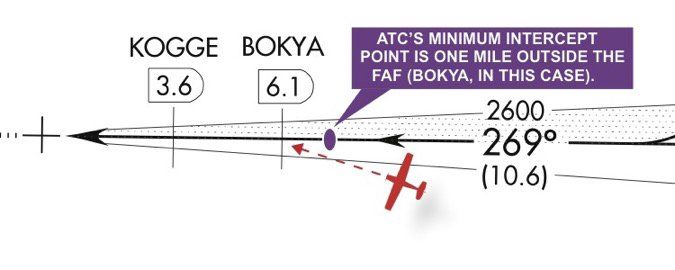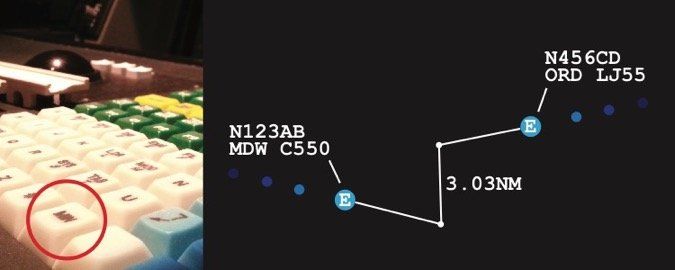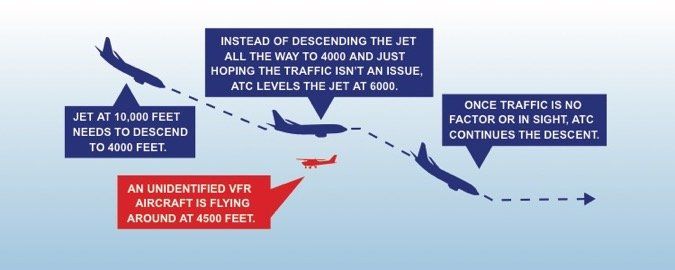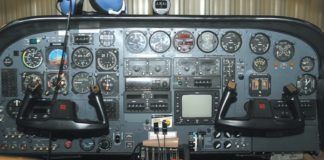Perfection is an unattainable illusion. No one gets it right all the time, and that includes air traffic controllers. We certainly try, given the safety stakes at play in our job. Human nature, however, has other ideas.
There could be any number of causes for an oversight. Maybe a controller’s just been plugged in too long on a busy day, getting his head kicked in by nonstop, complex traffic. Short staffing means there’s no break anywhere on the horizon. Oh, and he’s got to pee. I’ve been that guy. It’s not fun being tired, distracted, and inundated with airplanes.
Whatever the circumstances, even the best controller messes up sometimes. It’s a simple fact. The key thing, though, is catching those errors and quickly correcting them before a minor “Hmmm…” becomes something worthy of far more colorful language. Recognition of both the potential for and the existence of a mistake is a necessary skill.
Correcting a slip—and preventing them from happening in the first place—requires a palette of tools, techniques, and actions on the controller’s behalf, and some patience and cooperation on the part of pilots affected.

Staying Ahead of the Scope
Let’s talk about human factors for a second. Good task management is a strong mistake repellent. The faster a controller understands what actions or traffic conflicts need addressing, the more quickly he can resolve them. That leaves more time for effective decision making and scanning for future issues.
While we controllers work, we continuously analyze traffic on our radar scopes or outside our tower windows, ensure aircraft are filed on appropriate routes, and keep our workspace organized, among many other duties. We’re trained to be methodical and consistent in handling every aircraft, from our phraseology to our vectoring. It’s very similar in concept to cockpit procedures and checklists.
However, a rapid increase in traffic complexity can leave a controller fighting to check all those boxes. When I’ve got thunderstorms flaring up everywhere, 15 airplanes on my frequency deviating around them, and more arrivals flashing at my boundary, there’s an increased risk of a necessary vector or traffic call slipping through the cracks. A controller must be able to immediately go from zero to 60. The farther he drops behind, the harder it’ll be to catch up, and the easier it is to miss something vital.
The danger doesn’t end when the traffic settles down, either. Imagine a track-and-field runner after completing a 400-meter dash. He can sit, catch his breath, and forget about everything else for a bit. Once a tough job’s over, it’s human nature to kick back and let one’s guard down. Controllers can’t allow such complacency to take hold. FAA statistics show that many controller operational errors occur immediately after a drop in traffic. We must remain engaged, even in the lulls between the waves.
Overthinking things can be problematic too, especially with trainee controllers. Initially, they’ll of course be inexperienced in handling many situations. Their instructors will, over time, teach them a myriad of techniques. As a newbie’s toolbox grows, though, he may have difficulty deciding which specific tool to use in resolving a conflict. Do they vector airplane A? Descend airplane B? Slow them both down? Or…?
This is commonly called “paralysis of analysis,” essentially tunnel vision. Their mental processor is running full tilt weighing choices for one plane, while everything else that still needs doing fades away into the background. Other aircraft are blowing across final, not getting climbed or descended, and generally getting ignored. Not good. The trainee must learn to just make a decision quickly and not dwell on one task.
Finagling the Final
One of the most common areas for mistakes is a final approach sequence. Here, we’re taking aircraft of many types—jets, turboprops, helicopters, piston singles—coming from all directions, putting them all at very similar altitudes, and merging them into a single line to a particular runway. It can take a lot of finesse and good judgment to pry order from that chaos. One mistake with an aircraft in front can reverberate with all aircraft following it.
Imagine I’m vectoring you on a base leg for an ILS approach, number two for the runway. Our minimum nose-to-tail spacing requirement on final between IFR aircraft is three miles. That distance ratchets up depending if the trailing airplane’s a smaller wake turbulence category than the lead one. I realize I’m not getting the space I need between you and the preceding airplane. Maybe I forgot to slow you down or vectored you too close. Perhaps I forgot to tell the lead aircraft to keep his speed up.
Let’s say I’m short about 1.5 miles. What’s a quick way to build that distance? Keep you on the base heading, run you through the final, then turn you onto it from the opposite side. First, I’m required to say, “Expect vectors across final for (spacing/sequencing/etc.).” Next, I’ll let you go at least three quarters of a mile past the final, and then give you a 180 degree turn back towards it. My elementary math says that’s over 1.5 miles total, right? A quick jog across the final saved the day.
Now, what if a vector isn’t going to let you intercept the final properly? Legally, I’m supposed to have you intercept the final at a point no closer than one mile outside the final approach fix (FAF) for ground-based navaid approaches (ILS, Localizer, VOR, NDB), or a minimum of three miles outside when ceilings are low or you’re being vectored for an RNAV approach.
Maybe that 180-degree turn sticks you close to the FAF. What if other airplanes check in back-to-back, and I can’t get a word in until you’re almost on top of the final? Perhaps I (unfortunately) chose to speak to another aircraft, instead of clearing you for your approach? Fixing this could require your consent.
FAA Order 7110.65 5-9-1 (a) (2) says, “If specifically requested by the pilot, aircraft may be vectored to intercept the final approach course inside the approach gate but no closer than the final approach fix.” (Note: this does not apply for RNAV approaches, since they must be at least three miles from the FAF for WAAS capture.) I’ll just say, in plain English, “The vector will have you intercepting final at/very near the final approach fix. Can you accept that, or would you like to be re-vectored for another attempt?”
Yes, I am passing the decision on to you. Regardless of the reason, you’re not getting a perfect vector to final, and I’m simply explaining the situation. Do not hesitate to request vectors for another attempt or request clarification, or feel pressured by ATC to intercept closer than what makes you comfortable. By saying you can accept the vector, when given an option not to take it, you’re satisfying my requirement for a “specific request by the pilot.” If you’re fine with it, that’s great. Would you rather break off and give it another go? The choice is yours; choose what’s best for you.

Stepping Down
One obvious truth of traffic flow is: “Arrivals descend and departures climb.” Getting those planes up to and down from cruising altitudes can be a bit tricky when there’s lots of crossing traffic in the way. Every aircraft and every pilot flies differently, potentially turning each clearance into a gamble.
I had one jet arrival at 10,000 feet, indicating 350 knots across the ground. I cleared him down to 5000 feet, expecting him to get below an IFR overflight at 6000. However, due to the 250-knots-below-10,000 speed restriction, he needed to slow before going any lower. That took longer than I expected, delaying his descent. As he dropped through 8500 feet, I saw I might lose my required three miles of lateral separation. My options? Turn him or stop his descent. I chose the latter. “Amend altitude. Maintain 7000. Traffic, one o’clock…”
For departures, it’s ideal for us to get them climbing and on course as fast as possible. Before a new altitude assignment, we examine the aircraft’s path for conflicts. Sometimes, though, it’s traffic behind them that’s a problem. Once, I climbed a departing Cessna Skyhawk to 4000. Twenty miles in trail of him was a Cessna TTX, going a hundred knots faster at the same altitude. I was handling some other situations, so I didn’t immediately catch the speed differential.
When I did see it, I had to make a quick decision. Do I turn the Skyhawk out of his way and let the TTX blow past him? Sure, but that would have involved watching both aircraft pretty intensely and inconveniencing the Skyhawk with multiple vectors off course. The easiest choice? Climb the TTX. I asked him, “For traffic, can you accept 6000 feet as your final altitude?” He replied in the affirmative, so up he went. Twice my minimum vertical separation of 1000 feet meant no babysitting required.
Our conflict resolution duties don’t end at our hard airspace boundary. If we observe traffic in our jurisdiction that might converge in the next controller or facility’s airspace, we’ll try to fix it within ours, often by changing their altitudes. We try to be considerate team players. It’s a golden rule thing: treat others the way you wish to be treated.
Gut Check
So far, I’ve only talked about radar situations, but there is no shortage of “gotcha” moments in the tower as well. Often, these seem more intense, since we are seeing the actual aircraft out the window instead of just some abstract targets on a radar scope.
I was newly certified at my first tower, and I was getting my butt kicked by traffic one day. I cleared an Airbus A320 for takeoff. Just as the word “takeoff” left my lips, I scanned back towards the final, and gasped. I’d been distracted getting multiple upwind aircraft out of his way and completely forgot about a turboprop on a two-mile final. “Cancel takeoff clearance! Hold short Runway 27!” The Airbus held short, and everything worked out. No ugly go-arounds for me that day.
It wasn’t until later in the day that the severity of my error hit me. The incident popped in my head while I was grocery shopping with my wife, and with it came a sickening feeling in my stomach. I just had to stand there quietly for a minute among the canned goods and taco shells while I obsessed over the situation. It’s true when people say that nothing teaches like a good scare. That moment drove home that I must always scan my final and my runway first, no matter how busy I got.
Every situation here is based on something that has actually happened to me. They didn’t all happen in one shift, or even in one decade. However, I remember each clearly because of how they impacted me. From them, I learned how to be a more effective controller and recover more quickly when I miss something.
Making a mistake isn’t the end of the world. However, good controllers are often judged not as much by the errors we make, but by how we handle our errors. The worst thing a controller can do after goofing is to compound it by making rash decisions. Instead, by relying on foresight and proven techniques, he can put himself and the pilots under his purview safely back on the right track.
Be Positive
When I was first learning to work radar, one of my (very patient) trainers told me, “Radar monitoring isn’t good enough. You need to use positive control.” I didn’t quite grasp her meaning at that time, being so new. As she explained, “radar monitoring” was her fancy-speak for: “Eh, I’ll just watch it and see how it works out.”
And what about that other term, “positive control”? Picture yourself cruising down a highway. A car in your lane starts slowing down ahead of you. Do you stay in that lane, waiting to see if the car speeds back up, tensing to hit the brakes if he doesn’t? Or, do you smoothly change into the next lane, so his speed has zero effect on you? If you choose the latter, that’s “positive control.” Rather than watching and hoping things just work themselves out, you removed yourself from the conflict.
It may seem obvious, but for many new controllers, it takes lots of time to learn this concept. Even when they spot an impending problem, they might just tell themselves to keep an eye on it. As it often happens, though, they get distracted by other things and forget about that first situation. If it’s not caught in time, they could end up issuing panic vectors or experiencing an operational error.

That was the most important lesson my trainer taught me: if something looks like it might become a problem, one easy step may correct it well in advance. Are two aircraft 40 miles apart converging on the same point? Don’t wait until they’re a couple of miles from one another and the conflict alert alarm is wailing away. Change their altitudes or vector them right from the beginning.
The same goes for traffic advisories. If I have to descend a jet from 10,000 feet down to 4000 feet, but I have an unidentified VFR target fooling around in his way at 4500, I’ll instead clear the jet to descend only to 6000 feet. Yes, the VFR airplane should be “seeing and avoiding” anything around it, as should the jet if in VMC, but there’s zero guarantee they’ll see each other. One move in the wrong direction means the jet’s responding to a TCAS resolution advisory and both the pilot and I could be filling out paperwork. Instead, once the jet gets down to 6000 feet, I’ll issue traffic. If Mr. Jet gets Mr. VFR in sight, then I’ll clear Mr. Jet down to 4000 feet and we’re all happy.
The busier a controller gets, the more his attention gets divided. That leaves less time to monitor each airplane. One or two well-considered transmissions can completely reduce ATC workload and the potential for safety incidents down the road. That’s a definite “positive.” —TK
Tarrance Kramer’s aim for perfection sometimes falls short of the bullseye, but the years have at least taught him how to pull off a quick save.




